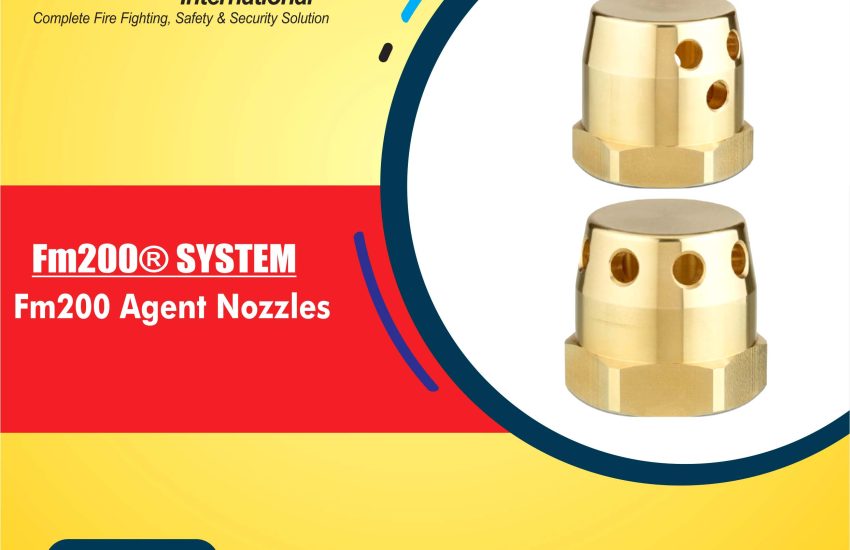FM200 Agent Nozzles has become a top choice for fire suppression systems due to its effectiveness and environmental benefits. One crucial part of this system is the FM200 agent nozzle. This guide will walk you through the role of FM200 agent nozzles, how they work, and why they are essential. We will also cover their installation process and maintenance to help you keep your system operating at its best.
What Are FM200 Agent Nozzles?
FM200 agent nozzles are essential components in FM200 fire suppression systems. These nozzles release the FM200 fire extinguishing agent during a fire emergency. FM200, also known as HFC-227ea, is a clean agent that suppresses fires effectively without damaging sensitive electronic equipment. The nozzles distribute the agent evenly, ensuring rapid fire suppression and minimizing the risk of property damage.
Why Are FM200 Agent Nozzles Important?
FM200 agent nozzles improve the overall performance of the fire suppression system. They ensure the FM200 agent spreads evenly across the room or area, resulting in quick suppression. The even distribution reduces fire damage and prevents the fire from spreading further.
Here are the key benefits of FM200 agent nozzle:
- Precise Distribution: These nozzle spread the FM200 agent uniformly, ensuring complete coverage.
- Rapid Response: They act quickly to suppress fires, reducing the risk of property loss.
- Environmentally Friendly: FM200 leaves no residue and poses minimal environmental impact.
- Non-damaging: The nozzles protect sensitive electronics, which is why they are ideal for places like data centers and server rooms.
Types of FM200 Agent Nozzle
Different FM200 nozzles serve specific applications. These include:
- Standard Nozzles: These nozzles are the most commonly used in general fire suppression scenarios. They evenly distribute the agent across small to medium-sized rooms.
- Extended Nozzles: For large rooms or areas with hard-to-reach spots, extended nozzles ensure the agent spreads effectively.
- Spray Nozzles: Spray nozzles provide wider coverage, making them ideal for areas with high ceilings or larger protection zones.
- Deflector Nozzles: These nozzles direct the agent toward specific areas, ensuring proper coverage in fire-prone locations.
How Do FM200 Agent Nozzles Work?
FM200 agent nozzle connect to a network of pipes attached to an FM200 cylinder. When the system detects a fire, it activates and releases the FM200 agent through the nozzle. The nozzles then disperse the agent throughout the space. FM200 works by reducing oxygen levels and interrupting the chemical reactions that fuel the fire, which ultimately extinguishes it.
FM200 is a clean agent that evaporates quickly, leaving no residue behind. This feature makes it ideal for environments where sensitive equipment, such as computers and servers, must remain unaffected.
Installation of FM200 Agent Nozzles
Proper installation of FM200 agent nozzle ensures that the fire suppression system works effectively when needed. The installation process includes several steps:
- System Design: A thorough evaluation of your facility’s layout helps determine the optimal placement of nozzles. Room size, ceiling height, and overall layout all influence nozzle placement.
- Nozzle Placement: Nozzle are installed in areas where they will best distribute the FM200 agent. Typically, they are positioned on the ceiling or walls, depending on the structure of the space.
- Piping Connections: The nozzle connect to a piping network that delivers the FM200 agent. It is important to size the pipes correctly to maintain the necessary pressure and flow for effective suppression.
- System Testing: After installation, testing ensures that the nozzles function correctly and that the system will activate properly in an emergency.
FM200 Agent Nozzles Maintenance
Like all components of a fire suppression system, FM200 agent nozzle require regular maintenance. Here are some essential maintenance tasks:
- Inspection: Regularly check the nozzles to ensure they are clear of blockages and in good condition.
- Cleaning: Dust and debris can clog nozzles, reducing their effectiveness. Regular cleaning ensures proper agent distribution.
- System Testing: Conduct routine tests to verify that the FM200 agent will be discharged as intended in case of a fire.
Factors to Consider When Choosing FM200 Agent Nozzles
When selecting FM200 agent nozzle, consider the following factors:
- Room Size and Layout: The layout and size of the room will determine the number and type of nozzles needed for proper coverage.
- Ceiling Height: In high-ceilinged spaces, extended nozzles might be necessary to ensure sufficient coverage.
- Type of Equipment: If you are protecting sensitive electronic equipment, opt for nozzles that use clean agents to prevent damage.
- Compliance with Standards: Make sure the FM200 nozzles meet industry standards, such as NFPA 2001, to ensure reliable operation.
Conclusion
FM200 Agent Nozzle are critical for the effective operation of an FM200 fire suppression system. By ensuring that the agent spreads evenly and quickly, these nozzles provide reliable fire protection, especially for environments containing sensitive equipment. Understanding the different types of nozzles, installation process, and maintenance requirements can help you choose the right nozzles and maintain your system’s peak performance.


